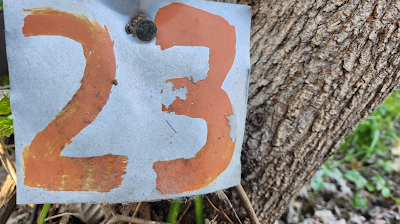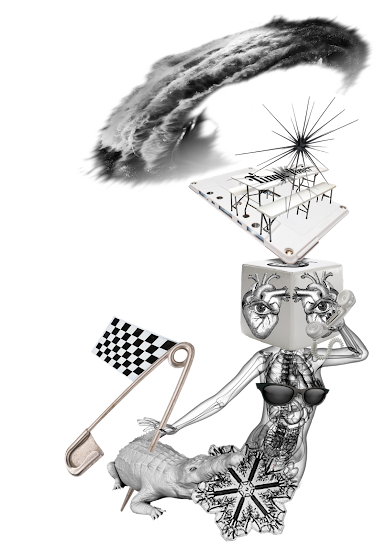"What's class number twenty-six?" asked the man who had just read the official 66th Annual Vermont Antique Car Show document, displayed on the dash of my 2015 smart fortwo. (The card read: Class #26: Display Only, special interest groups 1989-2023, not judged.) I did not stand up from my lounge chair to greet him. Instead, I merely said, 'not judged' from the comfort of the portable screened gazebo I'd put in the back of my stall, behind the tiny car.
He walked with a stiff posture, carried around some permanently crinkled face muscles, and talked with a bully's 'searching-for-someone-who-deserves-it' demeanor. "What's with this snapperhead?" he indicated towards my license plate.
"That's related to my artwork."
His sneer-scoff was just noticeable as a nose-twitch-lip-curl as he came towards the gazebo's zipper-door and said, "You're an artist. What kind of art do you do?"
I got up and said, "Like this image." As I exited the shade, patting my chest, he stared at me too long because (I think) he couldn't tell if I was holding eye-contact, because I was wearing ultra-dark mountaineering sunglasses with side-shields (which relaxed my Asperger-desire to look away from faces). He could, however, read my smile, easy attitude, close-trimmed full-white beard, and colorful hat.
He glanced longer than necessary at the abstract splash-type of shape (the color of faded-blood) on my hoodie. "Some weird shit. Don't get it. I guess it's not..."
I intentionally cut him off: "New England. It's the outline of New England."
"Bullshit." He batted my statement down with a waist-level flap of wrist.
I tipped my head to the left and said, "Not everyone can see it."
"Oh, I see it. It's just. That's not art."
"Not everyone likes what I create. That's their prerogative." I said, turning and zipping myself back inside my bug-free shade.
፨ ፨ ፨
"I would like to thank you so much for being here today. I love-love-love that you've displayed it all. And done it this way. I love it so much! It looks almost like the car might fit inside the pop-up? Is it one of those tents that goes up in seconds?" The energetic lady, comfortably dressed, comfortable in her middle-age, asked as she took out a phone and photographed the black-on-grey trademark logo [Quick-Set by Clam].
"Thank you. Yes, it does only take a couple minutes to put up. The car might fit inside, but the front-end will stick out a foot or so because this is the six-foot gazebo." As I talked she leaned inside the top-down convertible and said/asked what everyone says/asks: ...Didn't know they made a convertible; more room inside than imagined; thought all smart cars were electric; are highway-speeds safe; how much would a used one cost; is winter driving feasible... et cetera. I answered questions and thought I recognized a fellow-Asperger's by her obvious non-conformist streak.
፨ ፨ ፨
Not all of "us" are intentionally non-conformists. Some of "us" are unaware of certain types of "unspoken" societal or cultural norms (pertaining to behaviors, dress, attitudes, or appearance). "We" can't choose to intentionally not conform with something in "our" blindxpot.
As an example: I was in the National Gallery of Art in DC when a distinguished professor (whom I had previously recognized as one of "us") laid down on the floor next to a series of Giacometti sculptures being displayed on several large, shin-to-knee, coffee table level pedestals. He then raised his voice to a shout, proclaiming that the curators were idiots to have made it impossible to see these tiny, thin, bronze artworks without sitting or lying on the floor. Docents descended on the shouting man dressed in crumpled disheveled as if he were a member of the unhoused-population. He calmly explained himself and was steered towards a suggestion box. Professor Carmody's protest was not rude non-conformity; it was just that: "how to behave in a museum" occupied a blindxpot.
፨ ፨ ፨
Before displaying my smart subcompact vehicle at a car show, which predominantly contained trucks, muscle cars, racers, hot-rods, and museum showpieces, I thought it would be admired as something very few people here, in Vermont, were familiar with. I was parked not far from a pristine '91 Nissan Figaro (also a class #26; even though it looks like it's from the 1950s). My blindxpot: I had no idea there were so many people (predominantly male) who hate the idea my subcompact car suggests by its existence.
I was booed with thumbs-down and middle-fingers up. More than one person exclaimed they thought it was visually ugly. A man my age (red hat with four white letters) shouted as close to my face as tent-screen permitted, "WELCOME TO THE 21st CENTURY!!" (confusing; maybe he meant 20th). It was referred to as a "nostalgia buzz-kill." A child said, "we don't like this, do we Daddy?" I received more than a handful of: "Well, don't you look comfy?" (oddly demeaning, but I was very comfy). Another said in my direction (while pretending they were talking to the person they were with): "...more like a seedling-hugger, 'cause it's too small to hug a whole tree!"
That last one was so good I intend to print a version of it on next year's hoodie. Because (as regular readers don't need reminding) I am an intentional non-conformist. While I enjoy exchanging ideas with the intellectually curious, I'm especially proud when my lack of conformity hits a nerve in conformists and their incurious comrades.
Don't get too comfy:









.jpg)













































